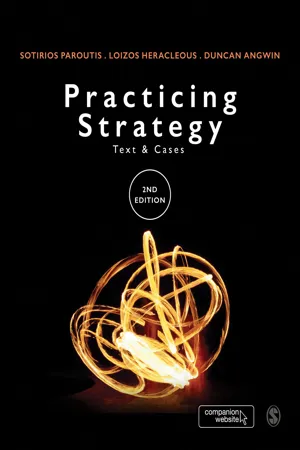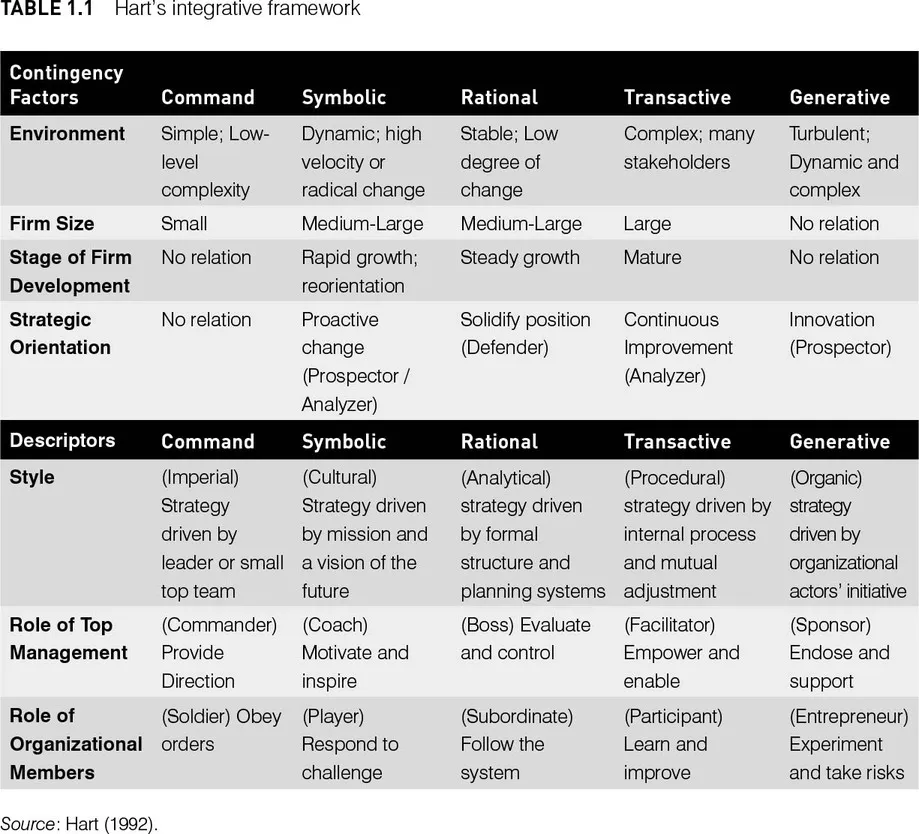
- 328 pages
- English
- ePUB (mobile friendly)
- Available on iOS & Android
eBook - ePub
About this book
Shortlisted for the 2013 Chartered Management Institute textbook award Practicing Strategy broke new ground when it first published byfocusing on the strategy-as-practice approach, which considers strategy not only as something an organisation has but something which its members do.
The new edition deals with a selection of topics that have been central in recent academic debates in the strategy-as-practice area and includes
- 7 New chapters on topics such as Chief Executive Officers, Middle Managers, Strategic Alignment and Strategic Ambidexterity in line with developments in the field
- New case studies throughout including Narayana health, the turnaround of Reliant group and relocating a business school
- Tutor and student access to online resources inlcude additional readings, an Instructor?s Manual, PowerPoint slides, author podcasts and videos.
Aimed atundergraduate and postgraduate students taking advanced strategy modules and practitioners alike.
Frequently asked questions
Yes, you can cancel anytime from the Subscription tab in your account settings on the Perlego website. Your subscription will stay active until the end of your current billing period. Learn how to cancel your subscription.
At the moment all of our mobile-responsive ePub books are available to download via the app. Most of our PDFs are also available to download and we're working on making the final remaining ones downloadable now. Learn more here.
Perlego offers two plans: Essential and Complete
- Essential is ideal for learners and professionals who enjoy exploring a wide range of subjects. Access the Essential Library with 800,000+ trusted titles and best-sellers across business, personal growth, and the humanities. Includes unlimited reading time and Standard Read Aloud voice.
- Complete: Perfect for advanced learners and researchers needing full, unrestricted access. Unlock 1.4M+ books across hundreds of subjects, including academic and specialized titles. The Complete Plan also includes advanced features like Premium Read Aloud and Research Assistant.
We are an online textbook subscription service, where you can get access to an entire online library for less than the price of a single book per month. With over 1 million books across 1000+ topics, we’ve got you covered! Learn more here.
Look out for the read-aloud symbol on your next book to see if you can listen to it. The read-aloud tool reads text aloud for you, highlighting the text as it is being read. You can pause it, speed it up and slow it down. Learn more here.
Yes! You can use the Perlego app on both iOS or Android devices to read anytime, anywhere — even offline. Perfect for commutes or when you’re on the go.
Please note we cannot support devices running on iOS 13 and Android 7 or earlier. Learn more about using the app.
Please note we cannot support devices running on iOS 13 and Android 7 or earlier. Learn more about using the app.
Yes, you can access Practicing Strategy by Sotirios Paroutis,Loizos Heracleous,Duncan Angwin in PDF and/or ePUB format, as well as other popular books in Business & Business Strategy. We have over one million books available in our catalogue for you to explore.
Information
1 Practicing Strategy: Foundations and Importance
Learning Objectives
- Provide a foundation to the rest of the book.
- Assist readers to locate the strategy-as-practice within the debates in the strategic management literature.
- Present the key concepts that will form the backbone of the textbook (notably, the practitioners, practices, and praxis framework).
1.1 Overview
The purpose of this chapter is to introduce the reader in the field of practice-based approaches to the study of strategy and organization, including its rationale and emergence. These will provide a basis for a clear identification of the key topics covered in the practice approach and a review of the main concepts involved in a key perspective to understand the practice of strategy: the strategy-as-practice perspective. By decoding the key concepts around the strategy-as-practice approach we encourage an appreciation of the micro-level aspects of strategy making and execution. Such micro-level aspects are not only of interest from a scholarly perspective, but also critical in any strategic review and can help practitioners develop a more nuanced understanding of the strengths and weaknesses of their strategy-making and execution processes. Overall, the key objective of this introductory chapter is to help the reader appreciate the micro-level foundations of strategy making and execution.
1.2 Strategy-Making Processes: The Search for Action
The field of strategic management is often divided into different schools of thought. The planning and emergent schools are two fundamental schools that have shaped, and still influence, many debates in academia and practice. Based on the work of Chandler (1962), the planning (or rational) school considers strategy as the outcome of the sequential activities of strategic analysis, development, and implementation. The emergent school, on the other hand, led by Henry Mintzberg, considers strategy as not simply a plan but also a pattern that emerges over time based on experimentation and discussion (Mintzberg, 1973, 1978, 1987; Mintzberg and Waters, 1985). Mintzberg notes that “organizations develop plans for the future and they also evolve patterns out of their past” (1994: 24). Accordingly, strategy is perceived as more than just an intended outcome based on a top-down procedure and as a more complex, emergent, bottom-up process developed throughout the organization with the participation of multiple organizational members. Based on the foundations of these two schools, a number of frameworks have been developed concerned with the strategy-making processes that firms follow. Combining the learning around strategy-making processes, Hart (1992) developed an integrative framework consisting of five models (see Table 1.1). The main advantage of this model is that it integrates many of the insights from pre-existing strategy models by contrasting the roles of different management actors. In that way, strategy making is viewed as an organization-wide phenomenon.
Alongside Hart, the Bower–Burgelman (BB) process model of strategy making (Burgelman, 1983, 2002) has been a milestone in strategy process research. Bower (1970) developed a resource allocation process (RAP) model which was later modified and extended by Burgelman in the early 1980s using rich empirical insights. The result was the BB process model (Bower and Doz, 1979; Burgelman, 1983). The foundation of this process model was an evolutionary framework of the strategy-making process in established firms (see Figure 1.1). Burgelman’s primary goal was to show the interactions between strategic behavior, corporate context, and the concept of corporate strategy. According to this model the strategy-making process is determined through strategic behavior that either is induced by top management or develops autonomously:
Autonomous strategic behavior introduces new categories for the definition of product or market opportunities. It develops from the bottom up within a company and covers project-championing efforts to mobilize corporate resources. Induced behavior on the other hand represents the guiding character of strategy. “The induced process concerns initiatives that are within the scope of the organization’s current strategy and build on existing organizational learning” (Burgelman, 1991: 241).
Structural context determination means the top-down introduction of formal organizational structures (information, evaluation, reward systems, etc.) to shape the selection of strategic investments. Strategic context determination covers political activities of middle management that aim at combining autonomous strategic behavior on the product-market level with the current corporate strategy.

Source: Hart (1992).
What is interesting about Burgelman’s approach is that this autonomous process is perceived as an integral part of the strategy-making process:
strategy making…involves keeping both processes (induced-autonomous) in play simultaneously at all times, even though one process or the other may be more prominent at different times in a company’s evolution… A company rationally tolerates autonomous strategic initiatives because such initiatives explore and potentially extend the boundaries of the company’s competencies and opportunities. (Burgelman, 2002: 14–15)
A deeper appreciation of the behavioral aspects shaping the strategy-making process comes from studies of managerial decision making. Miller and Friesen (1978) identified 11 strategy-making process dimensions including, for example, adaptiveness, analysis, expertise, integration, innovation, and risk taking. In his study, Fredrickson (1986) proposed dimensions such as proactivene...
Table of contents
- Cover
- Half Title
- Publisher Note
- Title Page
- Copyright Page
- Summary of Contents
- Contents
- Sidebar List
- Guided Tour of the Book
- Companion Website
- About the Authors
- Preface
- Praise for the First Edition
- 1 Practicing Strategy: Foundations and Importance
- A Practitioners
- 2 Chief Executive Officers
- 3 Chief Strategy Officers
- 4 Strategy Teams
- 5 Middle Managers
- 6 Strategy Consultants
- B Practices
- 7 Strategy Tools
- 8 Influencing Strategy through Discourse
- C Praxis
- 9 Strategic Alignment: The ESCO Model1
- 10 Practicing Strategy across Firms: Insights from M&As
- 11 Strategic Ambidexterity: Dealing with Tensions
- D Case Studies
- 12 Teaching Strategy using the Strategy-as-Practice approach
- 13 Strategic Leadership and Innovation at Apple Inc.1
- 14 Centrica: Strategizing in a Multi-utility1
- 15 Narayana Health: Bringing quality healthcare to the masses1
- 16 A “Reliable” Recovery? The Turnaround of the Reliant Group
- 17 Marconi: When Strategists Hit the Perfect Storm1
- 18 Lafarge vs. Blue Circle: Practices in a Hostile Takeover1
- 19 Room for Improvement? Relocating a Business School1
- 20 Strategy-Making 2.0: Strategy Development Process at the Wikimedia Foundation1 The Wikimedia Movement
- Index